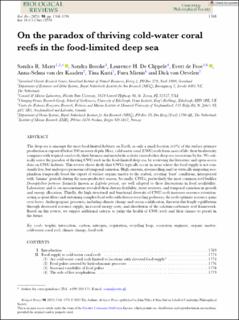| dc.description.abstract | The deep sea is amongst the most food-limited habitats on Earth, as only a small fraction (<4%) of the surface primary production is exported below 200 m water depth. Here, cold-water coral (CWC) reefs form oases of life: their biodiversity compares with tropical coral reefs, their biomass and metabolic activity exceed other deep-sea ecosystems by far. We critically assess the paradox of thriving CWC reefs in the food-limited deep sea, by reviewing the literature and open-access data on CWC habitats. This review shows firstly that CWCs typically occur in areas where the food supply is not constantly low, but undergoes pronounced temporal variation. High currents, downwelling and/or vertically migrating zooplankton temporally boost the export of surface organic matter to the seabed, creating ‘feast’ conditions, interspersed with ‘famine’ periods during the non-productive season. Secondly, CWCs, particularly the most common reef-builder Desmophyllum pertusum (formerly known as Lophelia pertusa), are well adapted to these fluctuations in food availability. Laboratory and in situ measurements revealed their dietary flexibility, tissue reserves, and temporal variation in growth and energy allocation. Thirdly, the high structural and functional diversity of CWC reefs increases resource retention: acting as giant filters and sustaining complex food webs with diverse recycling pathways, the reefs optimise resource gains over losses. Anthropogenic pressures, including climate change and ocean acidification, threaten this fragile equilibrium through decreased resource supply, increased energy costs, and dissolution of the calcium-carbonate reef framework. Based on this review, we suggest additional criteria to judge the health of CWC reefs and their chance to persist in the future. | |
